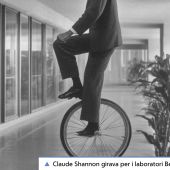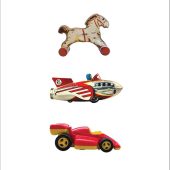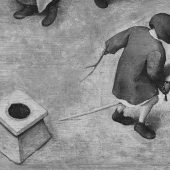Outside, in the garden, it was playtime. Naked in the warm June sunshine, six or seven hundred little boys and girls were running with shrill yells overs the lawns, or playing ball games, or squatting silently in twos or threes among the flowering shrubs […] The air was drowsy with the murmur of bees and helicopters.
The Director and his students stood for a short time watching a game of Centrifugal Bumble-puppy. Twenty children were grouped in a circle round a chrome steel tower. A ball thrown up so as to land on the platform at the top of the tower rolled down into the interior, fell on a rapidly rotating disk, was hurled through one or other of the numerous apertures pierced in the cylindrical casing, and had to be caught.
“Strange,” mused the Director, as they turned away, “strange to think that even in Our Ford’s day most games were played without more apparatus than a ball or two and a few sticks and perhaps a bit of netting, imagine the folly of allowing people to play elaborate games which do nothing whatever to increase consumption. It’s madness. Nowadays the Controllers won’t approve of any new game unless it can be shown that it requires at least as much apparatus as the most complicated of existing games.”
Aldous HuxleyBrave New World, 1932.
In the late twentieth and early twenty-first centuries, Huxley’s dystopia has generally been regarded as prophetic of social and genetic engineering. Mond’s musing in this passage epitomises the book’s nightmarish all-encompassing consumer culture. This over-engineered game, Centrifugal Bumble-puppy, in particular resonates with contemporary misgivings over children’s toy and play cultures and playthings in the digital era. Videogames, it is often argued, limit or even”colonise” the imagination, whereas the fate of the much-loved Lego is bemoaned: no longer the free and creative toy it once was, kids would be happier playing with the cardboard box these sophisticated toy are packaged in.
Centrifugal Bumble-puppy then is a challenge from the past and future for these Play Sandbox projects not least Light Bug, our augmented swing. Why, we need to ask ourselves, do kids need new apparatus, at least as much ‘as the most complicated of existing games,’ rather than – say – just more time and space to play with existing objects?
I suggest two answers:
l. I’d resist commonsense distinctions between “technological” and traditional ” toys, games and play. Games and play have always had their devices, technologies and technics. Egyptian board game tokens and Roman knuckle bones mediated place-holding and calculation, and hence memory and imagination, and mechanised the operations of chance for play. Commercial toy culture has its roots in the eighteenth century, and the clockwork mechanisms and interactive paper engineering of Victorian toys and books are now seen as thoroughly charming.
2. However, though children have taken pleasure from complicated apparatuses over the centuries, digital media and virtual or augmented play worlds are new and different in important ways (more on this in a future blog post). And these differences are not necessarily the superfluous and flimsy accretions of consumer culture satirised in the Centrifugal Bumblepuppy. Well-designed videogames and participatory media applications suggest, encourage, trigger, new types of imaginative, competitive or simply time-passing play. Play’s relationship to the serious world within which it erupts is never one of straightforward mimesis, but it does relate to it, adapt it, invert it, remix it. In an everyday environment replete with, and partly accessed through, complicated digital media, complicated digital media toys are required (alongside trees and cardboard boxes) to make (non)sense of it.






While I do agree with what you said, I found it more so meaning that kids were content with playing with simple items such as sticks and balls before the Ford times, but because these did not drive consumption, which one of the main goals of the Controllers, they created complex apparatus to drive it.